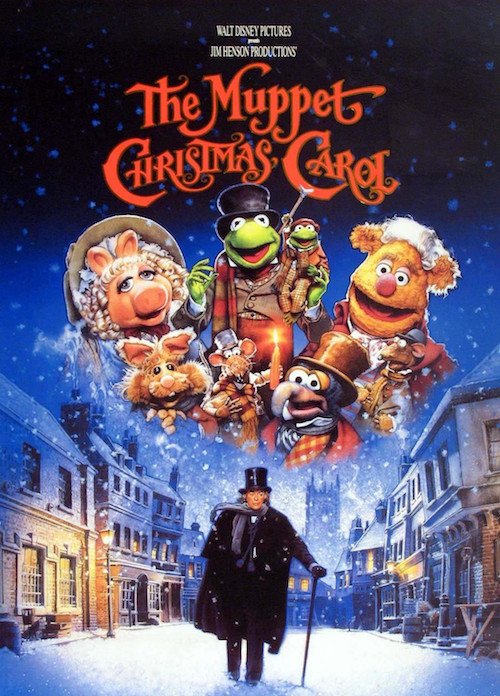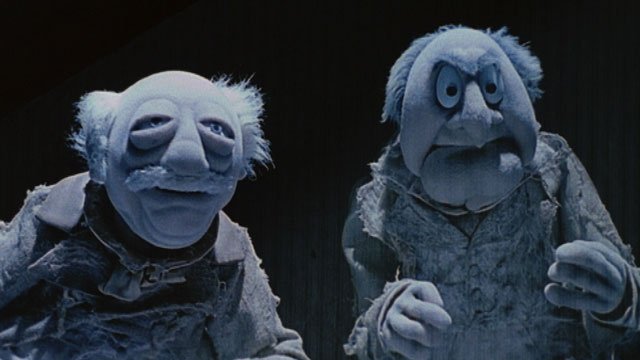Literature on Film | Part 3 | “Leave comedy to the bears, Ebenezer!” – A Tribute to The Muppet Christmas Carol
Jim Henson was dead: to begin with. This must be distinctly understood, or nothing wonderful can come of the story I am going to relate.
Published in 1843, A Christmas Carol by Charles Dickens is among the most adapted stories to Film and Television. The earliest known surviving adaptation is Scrooge, or, Marley’s Ghost a five minute silent from 1901 and since then the story of Ebenezer Scrooge, the cruel miser whose Christmas Eve visits from three ghosts causes him to see the errors of his ways, has seen traditional translations to screen via George C. Scott and Patrick Stewart and out of left field reworkings like Scrooged with Bill Murray or Blackadder’s Christmas Carol. Even the Tardis visited a crumogeony Michael Gambon one Christmas. Many of these are fine, even great films but I knew which one of the many, many versions was the closet to my heart and which one I would write about today. It was the one with the singing vegetables.

A lot rode on The Muppet Christmas Carol. Based on an idea by Henson before he died and directed by his son, Brian Henson, it was the first test to see if the felt theatre group could survive the loss of their beloved creator (and also Richard Hunt, a founding puppeteer who died mid production). It was uncharted waters – not only it was the first Muppet film to be a literary adaptation, but the first to cast a human as the main character. For many reasons, this could have been a mitigated disaster but fortunately they had one of Britain’s most iconic actors and the greatest Christmas story ever written.
The film opens on a busy London street and immediately the viewers are plunged into a Victorian world where Muppet and human walk side by side. The London of MCC is a deceptively warm past, noisy and full of life, but not shying away from the poverty that is the key theme of the original story. Frozen mice with no cheese, living off the spoils of the belongings of dead men, an empty chair by the fireplace, occupied only by a tiny cutch. To steal Lillian Gish’s line from Night of the Hunter, It’s a hard world for little things.
However before we get too “Ghost of Christmas Yet To Come”, it is still a Muppets film so silly word play and slapstick reign. The theatre troupe are cast perfectly to their roles, from Kermit and Miss Piggy as Bob and Mrs. Cratchit to Fozzie Bear as Fozziwig (Mr. Fezziwig in the novel. Truly a pun so bad it could only be followed by a Wocka Wocka). The best of all is the old theatre cranks Waldorf and Statler as Jacob and Robert Marley, who rise from the grave to warn Scrooge but take advantage of the opportunity for an old fashioned heckle. This is a minor deviation from the novel where there is, of course, only one Marley. (It took me years of rewatching before it dawned on me that Robert’s name may be a reference to a famous real life Marley. Wocka Wocka).
But how about the human at the centre? Michael Caine gives a wonderfully understated performance as the famous miser. Commonly Scrooge is played to the hilt as the clutching grasping old skinflint with bug eyes and dramatic sneers (see Alister Sims’s magnetic – and frightening – performance in the 1951 adaptation), but instead, Caine plays Scrooge as a cold, insular man who long lost touch with his humanity. Crucially for the reality of the movie, it’s an entirely unwinking performance, never acknowledging the absurdity of Bob Cratchit been played by Kermit the Frog. Michael Caine himself said he played the role as if he was working with members of the Royal Shakespeare Company.

A masterstroke was to include Charles Dickens himself as played by Gonzo the Great. Through the film, Gonzo tells the story to the audience, while trying to keep up with Scrooge’s journey. He is accompanied by a doubtful Rizzo the Rat, who often points out that he is clearly a weird blue “whatever”, not an 19th century literary genius. This is not only a delightful way to poke fun at the idea of omniscient narrators but also according to the director, it was a stealth tactic to include more of Dicken’s original prose.
In fact, there are few adaptations as faithful as Muppets Christmas Carol. Much of the dialogue is lifted straight from the original text, and details not often included in adaptations such as the Ghost of Christmas Present going older as the night progresses are retained. In fact if one is as familiar with the film as this reviewer is, it’s difficult to not hear Gonzo’s voice telling you about the spirit of the season. One of the key differences (other than the presence of frogs married to pigs) is that the original text is considerably spookier, omitting a good deal of ghostly imagery from the first half of the book. Designed for younger audiences in mind, Gonzo and Rizzo’s presence and generally wacky behaviour serves to stop any scenes from getting too scary. It’s no coincidence that in the chilliest section, Scrooge’s trip to the future with a Ghost of Christmas Yet to Come, our narrators disappear and don’t return till the happy ending.
Interestingly, none of the three sprirts are played by existing Muppets. The Ghost of Christmas Past is a floating ethereal girl who frankly is more frightening than the Ghost of Christmas Yet To Come, who is no slouch as a giant grim figure with no face but excellent pointing at tomb stone skills. Thankfully the Ghost of Christmas Present is a welcome, jovial figure whose infectious spirit (Wocka Wocka) warms Scrooge to the season and gently chides Ebenezer about his misdeeds.
In keeping with a more upbeat tone, there is a choir book of musical numbers included. These songs were written by long time Henson collaborator Paul Williams, whose work on The Muppet Movie gave us the immortal “The Rainbow Connection”. Best known as a 70s hitmaker for the Carpenters and David Bowie, Paul Williams’s mastery of a catchy hook means the audience is carried from the moment of the gloomy opening number “Scrooge” to the final joyful note of “It Feels Like Christmas”. Managing to sound both poppy and time appropriate, they will hang around your head as you walk down any frost bitten streets.

A mild controversy has turned up in recent years among those whose childhood Christmases were accompanied by a well worn video copy. Included on Home Video only was “The Love is Gone”, a song in the mid section which features lost love Belle singing at length to explain why she is breaking off her engagement to Ebenezer. As a young person, this was a really draggy song which perplexingly featured no Muppets and was about love or regret or something that wasn’t singing vegetables. However after years and years of sitting through it, a type of Weepy Ballad Stockholm Syndrome set in and now a generation are outraged that it’s not on the DVD or the TV version or the Theatrical releases and we sit at their desks, weeping openingly while watching a rip someone put up on YouTube and remembering the inevitable march of Time. Oh Belle, it wasn’t Scrooge’s fault investments continued to be poor!
On its release it was somewhat of a financial disappointment in the Box Office but its popularity grew on home video and now is firmly enshrined one of the most popular Dickens adaptations. Disney repeated its formula of “Muppets + Public Domain Text + Human = Profit” for Muppet Treasure Island and The Muppets’ Wizard of Oz and Henson’s legacy was safe for another generation. So before I depart from here to rewatch it on the largest screen possible, I would like to assure you that Tiny Tim DIDN’T die, remind you to honour Christmas, and try to keep it all the year and confirm that it really does look like Beaker is giving Scrooge the finger at the start. Bless us, everyone!
That said, I will say you were alarmingly close to getting 1,500 words on my other current favourite Christmas Carol adaptation “Three Wise Women”, a Hallmark time travel movie I came across one night while a little merry. It stars Amy Huberman, Fionnula Flanagan and briefly Jamie Dornan and is a completely bonkers combination of amnesia, fatal diseases, Guardian Angels and dream inception, all set in Dublin in the past, present day and future, complete with holographic grandchildren. Maybe next year.
Featured Image credit: Telegraph.co.uk

